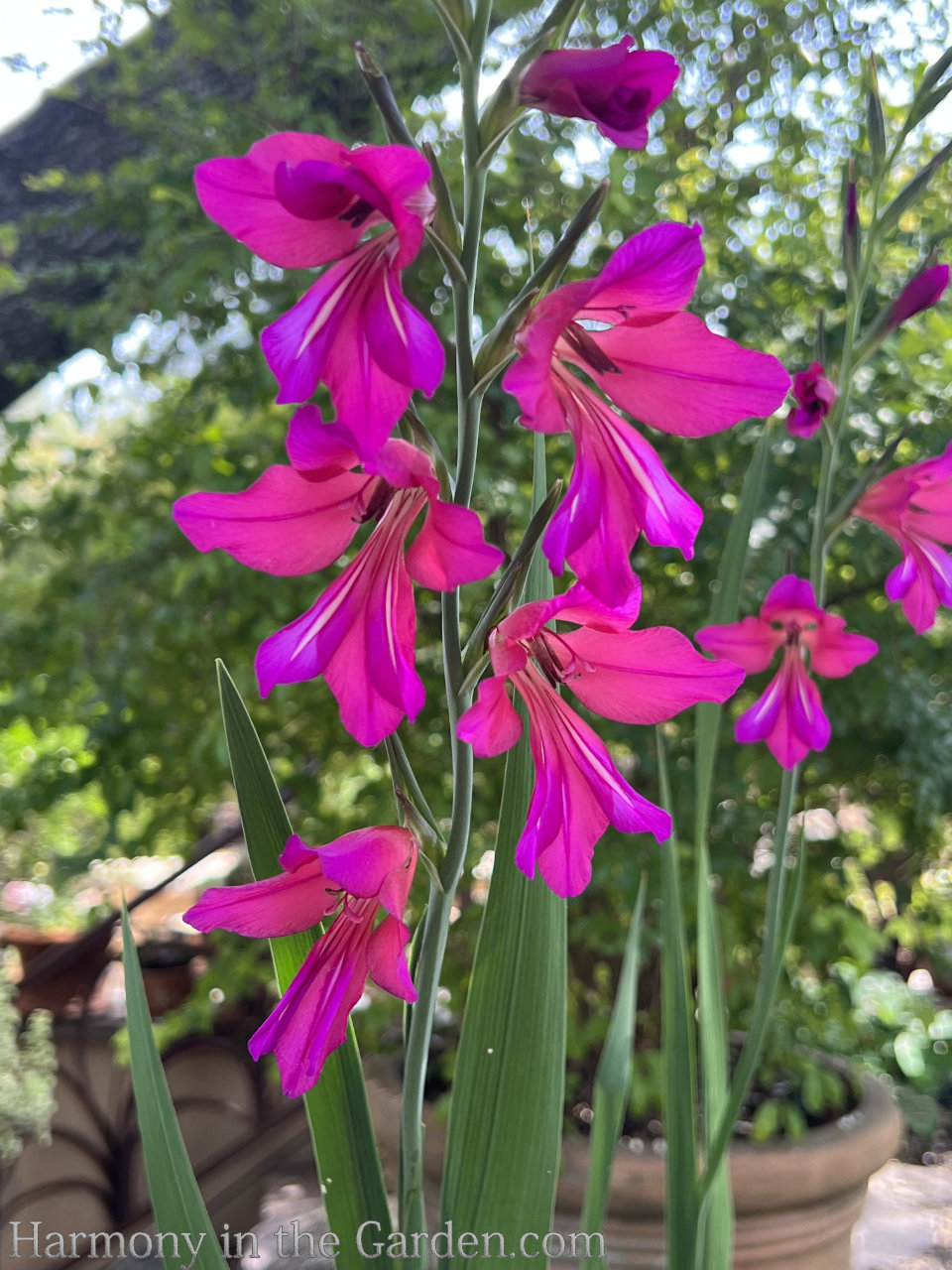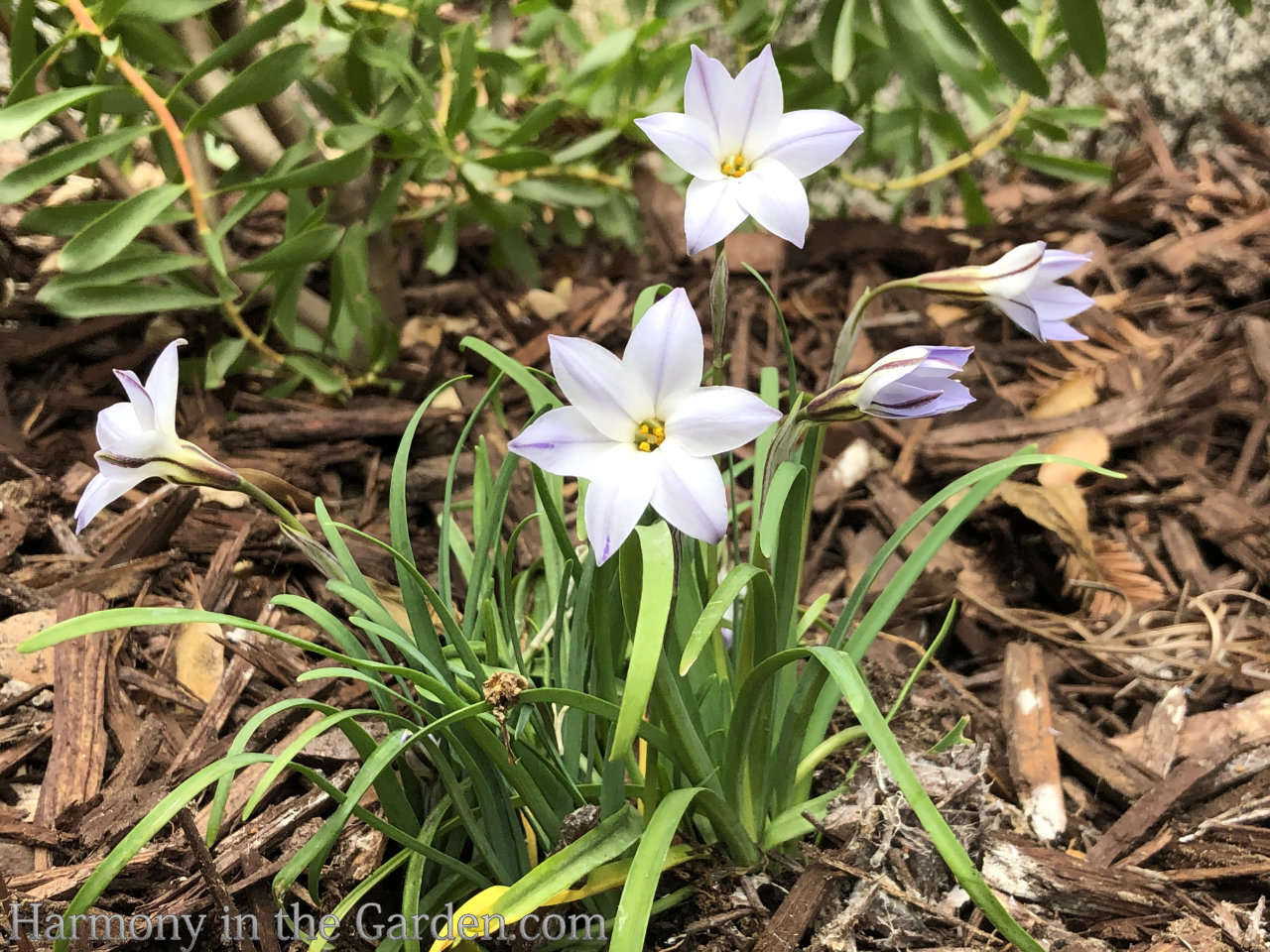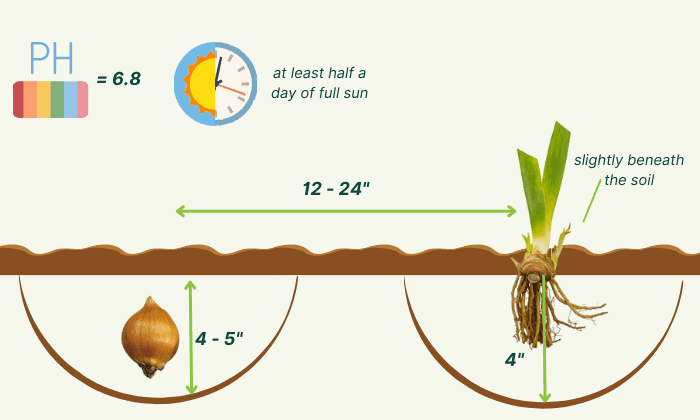People often ask me what my favorite spring bulbs are for warm climates and how I use them in my garden at this time of year.
You still have time to plant your spring-flowering bulbs if you live in a warmer area like I do in zone 9.
I want to plant all of my bulbs by December 1st if possible, that way they have plenty of time to settle down and “chill” before spring comes. But there’s still time if you’ve had a busy fall, as I have!.
It’s so true that I’m going outside this weekend to finish planting my last bulbs before the holidays.
But first, let’s talk about what winter chill means for people who live in places where winters are warmer.
Winter chill is necessary for most (but not all!) bulbs to bloom in spring. The prolonged colder temperatures force the bulbs into dormancy, allowing them to rest before their big show.
It is known that many daffodils and tulips need 12 weeks of soil temperatures that are 40 degrees or below, but galanthus, muscari, and others (listed below) need much less.
In general, bulbs that come up early in the season (like snowdrops and cyclamen) need less chilling time than bulbs that come up later in the spring (like tulips and narcissus). ).
First, let’s talk about how I use spring bulbs in my designs. Then, I’ll give you a list of my favorite bulbs for warm climates.
Also, I’ll put a video I made for Garden Design about fall-blooming bulbs at the end of this post.
If the bulbs are to be planted in the ground (vs. in a container), I often treat them as ephemerals.
If you haven’t heard of ephemerals before, they are small wildflowers that only bloom for a short time in very early spring.
Once the canopy of the trees fills out again, the ephemerals fade away until the following spring.
Even though bulbs aren’t really ephemerals, I plant them in the empty spaces left by big shrubs that lose their leaves in the fall.
For example, this is one of my very favorite shrubs in my garden – the native calycanthus ‘Aphrodite.’
Not only is it beautiful in the spring and summer, when it’s full of strong, sweet-smelling garnet flowers, but it’s also a blaze of color in the fall.
But in the winter, without any leaves, I’m left with a blank spot under the shrub.
This empty spot (outlined in yellow) is ideal for planting early-blooming bulbs, like snowdrops, narcissus or muscari (below.)
As the leaves start to get old and look unkempt, it’s tempting to clean up and get rid of them once the bulbs are done blooming. ).
But you should really fight the urge! The leaves that are still there are busy gathering energy to store in the bulb for next year’s flowers.
When designing with bulbs, I prefer to plant them behind or near low-growing perennials or shrubs.
Use nearby plants to hide the ugly leaves until they die back to wispy tan blades, at which point you can take them off. ).
In this example, I’ve planted narcissus ‘Yaz’ and ‘Blushing Lady’ behind low-growing and evergreen grevillea ‘Mt. Tamboritha’.
When the leaves start to fall over, I gather the strappy ones up neatly and tuck them behind the grevillea.
Finally, once the foliage turns tan and brittle, it’s time to remove it. When it’s ready to be removed, it should easily pull away from the bulb, with very little effort.
To be safe, though, and to keep from pulling the bulb out of the ground by accident, I usually cut it back with pruners.
When you plant bulbs, make a statement by arranging at least 12 of each type in a drift. This will create a moment of “wow.” This is NOT the time to be skimpy – go ahead and pack ’em in!.
One of my favorite tools for digging bulb holes is shown in this picture. It’s called the Cobrahead.
One thing I love about this tool is the Cobrahead’s shape—it has a spoon-shaped end and a sharp tip that cuts through the ground.
And the weight makes it super-fast, super-easy, and VERY satisfying to “thunk” when digging quick holes for bulbs (or for pulling oxalis weeds; click here to read how I do this). ).
CobraHead is a fantastic family-run business that makes all its tools in Wisconsin. They’re just awesome.
I like it when my garden bulbs look like they were there on their own, like they were planted there.
I achieve this by taking a handful of bulbs and loosely throwing them in the general area.
People who garden often do this, and the end result is always nicer to look at than if each bulb was carefully placed in a pattern.
It’s important to include bulbs that bloom at different times, just like when you design traditional garden beds with plants that bloom in all four seasons.
For example, some of the earliest blooming bulbs are cyclamen, zephranthes (rain lily), galanthus (snowdrops), or crocus.
Narcissus, jonquils, and tulips are the next flowers to bloom. In late spring, scilla, Byzantine gladiolas, calla lilies, and alliums will come next.
In fact, this past weekend, I was visiting my daughter, helping her plant several containers full of bulbs.
I showed her the concept of ‘lasagna planting’ by layering the bulbs according to bloom time.
In the container, left, we planted late-spring blooming tulips in the bottom layer (about 8” below the surface.)
Next, we planted early-blooming crocus on the top layer, just a few inches from the surface.
In the spring, crocuses bloom first, then tulips when the crocuses start to die back. This is called the spring bulb show.
To feed bulbs, I use a bulb fertilizer that can be used for many things (click here to see what I use). ).
A small handful of bulb food is lightly mixed into the bottom of the hole when I plant the bulb. It is also sprinkled on top of the soil after the bulb has finished flowering. ).
One of the joys of gardening in Zone 9 is the ability to grow a wide variety of spring-blooming bulbs. With the right timing, you can have a landscape filled with colorful tulips, daffodils, hyacinths and more. But when exactly is the optimal time for planting bulbs in this warm climate zone?
Follow this complete guide to determine the best time to plant bulbs in Zone 9 for success,
Why Planting Time Matters
Bulbs require a period of cool temperatures in order to bloom properly in spring. This cold period is referred to as the “chill hours” that bulbs need.
Different bulbs have different chill hour requirements based on where they originate. For example, tulips native to cooler climates need more prolonged cold than Mediterranean bulbs like freesia.
If bulbs don’t get enough chill time, they may produce leaves but no flowers, or blooms on short, stunted stems. Planting at the right time in fall and winter ensures bulbs get their needed chill hours.
When to Plant Popular Spring Bulbs
Here are some general guidelines for when to plant bulbs in Zone 9 for best results:
-
Tulips and hyacinths: Plant these bulbs that require more chill hours by late November. This gives them enough cool exposure to promote spring blooms. Pre-chilling bulbs indoors is an option too.
-
Daffodils and iris: Get daffodils, iris, and other moderate chill bulbs in the ground by mid December. This provides the 10-12 weeks of cold they need.
-
Freesia and ranunculus These and other low chill bulbs only require 4-6 weeks of cold. Plant from December through January
-
Anemones and lilies: Go ahead and plant anemones, Asiatic lilies, and other minimal chill bulbs in January and February.
-
Gladiolus and calla lilies Wait until the end of the chill period to plant these frost-tender bulbs in late February or March.
-
Summer bulbs: Hold off on warmth-loving bulbs like canna lily, caladium and dahlia until spring when frost danger has passed.
Tips for Zone 9 Bulb Planting Success
Follow these tips to get your spring bulbs off to the right start in Zone 9:
-
Research specific bulb varieties to learn their chill hour needs before purchasing. This ensures you pick suitable types.
-
Prepare planting beds in fall by amending soil and removing weeds. Bulbs thrive in nutrient-rich, well-draining soil.
-
Plant bulbs at the proper depth according to package directions. This is usually 2-3 times their height.
-
Water bulbs well after planting and continue watering during winter if rainfall is lacking. Moist soil helps bulbs root.
-
Consider planting in pots that can be moved to colder locations as needed to satisfy chill requirements.
-
Use protective mulches like leaves or straw to insulate bulbs from occasional freezes if temperatures fluctuate. Remove in spring as growth emerges.
-
Delay planting tender bulbs until late winter or early spring so they avoid cold damage.
The Impact of Climate Change
With climate change causing warmer average winter temperatures, bulbs may struggle to get their needed chill time in Zone 9. This can result in spotty or non-existent blooms.
To ensure success, gardeners in the warmest parts of Zone 9 may need to pre-chill bulbs indoors, focus on low chill varieties, or treat types like tulips as annuals to be replanted each year.
Watching long-term weather forecasts can help determine optimal planting times as patterns shift. Aim to plant bulbs about 4-6 weeks before your zone typically starts to warm in spring.
Extending the Bloom Season
One advantage of Zone 9 is the ability to spread out bulb bloom times over many months with careful selection and planting:
-
Winter: Plant paperwhites, amaryllis and early sprouting bulbs indoors in late fall for winter color.
-
Early spring: Snowdrops, crocus, and winter aconite emerge first in January and February.
-
Mid spring: Daffodils, tulips, hyacinths, and iris bloom from March through April.
-
Late spring: Alliums, lilies, gladiolus, and other summer bulbs flower in May and June.
-
Summer: Lilies, gladiolus and exotic bulbs like calla lily extend color into summer.
Staggering bulb plantings from fall through late winter guarantees bright flowers in your garden for months on end.
Be Patient for First Year Blooms
It’s important to be patient the first year after planting bulbs in Zone 9. Many bulbs won’t reach full flowering potential that first spring.
But with proper chilling and care, bulbs will build up food reserves to put on an increasingly spectacular show each successive year. Over time, many bulbs will multiply into impressive displays.
By planting bulbs at the optimal time for Zone 9, you can enjoy incredible spring flowering displays despite the warmer climate. Pay attention to chill hours, amend soil, provide winter protection, and select varieties wisely.
With the right bulbs for your growing conditions, a little patience, and proper planting techniques, your garden will burst into color come springtime.
Byzantine gladiolus (from Old House Gardens)
I’m normally not a huge fan of gladiolas. However, the smaller sized flower and hot magenta color of this heirloom variety has won me over!.
The magenta, red, and pink colors are the most beautiful you’ll ever see, but my camera doesn’t do them justice. If you have a large garden, these won’t get lost in the mix!.


Species tulips (not traditional tulips!)
Species tulips are different from the traditional, long-stemmed or parrot tulips that require winter chill. Species tulips are typically much smaller and daintier. Examples are tulipa sylvestris, t. clusiana, and t. saxatilis.
Over time, these tulips will naturalize into charming colonies that welcome spring’s arrival.
They need to be chilled first if you live in a warm area and want to plant traditional tulips. Click here to read how I do this.

Fall Planting Bulb Haul from Eden Brother’s! :: Zone 9b Fall Planted Bulbs for Spring Blooms!
FAQ
When should I plant tulip bulbs in zone 9?
Will daffodils grow in zone 9?
When can I plant gladiolus bulbs in zone 9?
What month should you plant bulbs?
What are Zone 9 bulbs?
Many of the common zone 9 bulbs are old favorites in the region and reflect a time gone by when life was slow and simple. Lilies, amaryllis, callas, and gladiolus …these are but a few common zone 9 bulbs, but there are also some truly unique and crazy plants that will thrive in those regions.
When to plant bulbs in Zone 9?
In Zone 9, late fall and early winter is the ideal time to plant bulbs. This typically falls between November and early December when the soil temperature is around 60°F or cooler. Planting bulbs during this time ensures they have enugh time to establish roots and prepare for the spring bloom season. What bulbs are best for Zone 9?
When do lilies bloom in Zone 9?
Rain lily: These bulbs produce stunning pink or white flowers after a heavy rain. Plant them in late fall and they’ll bloom in late winter or early spring. How to plant bulbs in Zone 9? 1. Prepare the soil: Make sure the soil is well-draining and rich in organic matter. Add compost or other organic material to improve the soil quality. 2.
Why do bulbs grow in Zone 9?
This is because temperatures in Zone 9 typically remain mild enough during this time to allow bulbs to establish their roots beore the colder winter weather sets in. Planting bulbs during this period also ensures that they receive sufficient moisture from the winter rains to help them grow healthy and strong.
- The Ultimate Guide to Growing Strawberries in Raised Beds - August 8, 2025
- No-Dig Garden Beds: The Easiest Way to Grow a Beautiful Garden - August 6, 2025
- How to Protect and Preserve Wood for Raised Garden Beds - August 6, 2025

